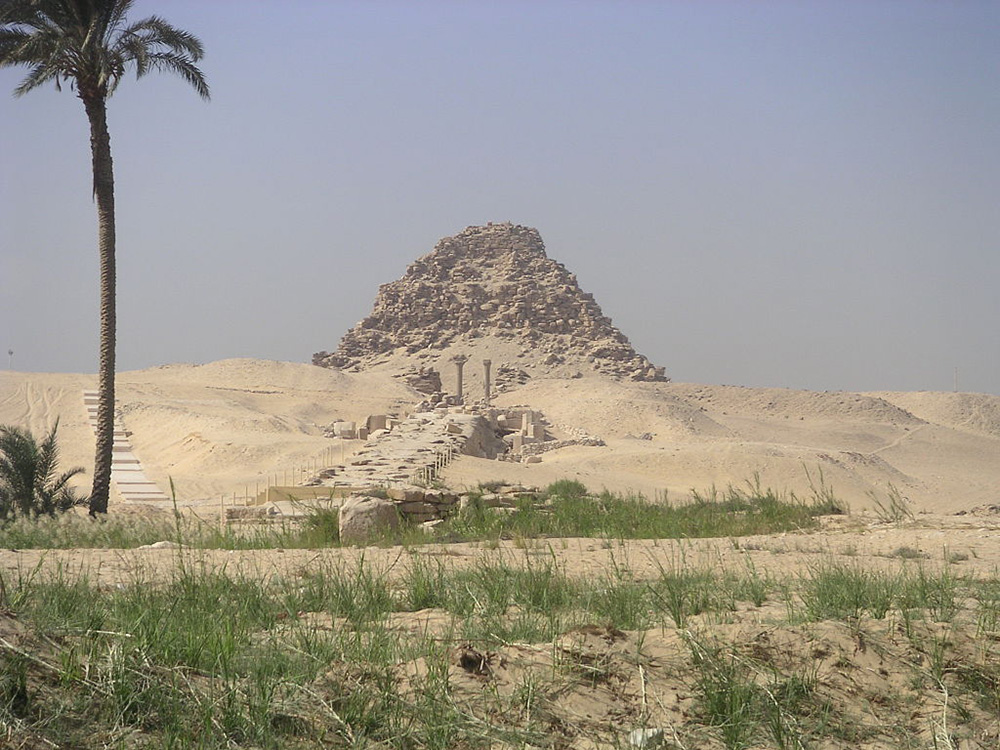

The Pyramid of Sahure (in ancient Egyptian Kha-ba Sahura -The rising of the ba spirit of Sahure is a late 26th century BC to 25th century BC pyramid complex built for the Egyptian pharaoh Sahure of the Fifth Dynasty. Sahure built the inaugural pyramid in Abusir after his direct predecessor, Userkaf, built his sun temple in the same area. Sahure's successors, Neferirkare Kakai, Neferefre, and Nyuserre Ini all built their monuments in the general vicinity. The complex's early visitors, John Shae Perring, Karl Richard Lepsius and Jacques de Morgan, did not conduct a thorough investigation, perhaps they were discouraged by its ruined state. It was first properly excavated by Ludwig Borchardt between March 1907 and 1908, who penned the seminal work on the topic Das Grabdenkmal des Konigs Sahu-Re between 1910 and 1913.
The monument consists of a main pyramid, mortuary temple adjacent the east face with a cult pyramid to its south, a valley temple on Abusir Lake, and a causeway linking the complex. The layout was developed by Sahure and adopted by succeeding kings of the Fifth and Sixth Dynasty, thus representing a milestone in pyramid complex construction. The monumentality of these constructions was drastically diminished, but, in tandem, the decorative program proliferated and temples were augmented by greater storeroom complexes.
The monument is estimated to have had 10,000 m2 (110,000 sq ft) of finely carved relief adorning its walls, of which a mere 150 m2 (1,600 sq ft) has been preserved. Certain of these preserved reliefs is considered unrivaled in execution, such as a massive 8 m (26 ft) by 3 m (9.8 ft) hunting scene from the mortuary temple. The temple itself is remarkable for the array of valuable materials - such as granite, alabaster and basalt - that were used in its construction.
The main pyramid had a core of steps built from mud mortar bound, roughly hewn limestone blocks that were encased with fine white Tura limestone. Adjacent to its eastern face, the mortuary temple was built consisting of five basic elements: an entrance hall, an open courtyard, a five niche statue chapel, an offering room and storerooms. These had been used in mortuary temples since the reign of Khafre, but here again, Sahure's layout was adopted as standard in all subsequent such temples in the Old Kingdom.
At the south-east corner of the main pyramid lay the enclosure of the cult pyramid, accessible either via a secondary entrance or a transverse corridor. The transverse corridor acted as an intersection separating the public and intimate temples, and connecting the various elements of the temple together. Beyond the temple's entrance hall, a 235 m (771 ft; 448 cu) long causeway led to the valley temple sited on the Abusir lake. In its rectangular plan, the valley temple had two entrances: its main on its east side, and an unexpected secondary entrance on its south. It remains unclear why a second entry point was built, though it may have been connected to a pyramid town to its south.
Sahure's temple became the object of a cult of Sekhmet around the Eighteenth Dynasty. The growing interest in Abusir heralded the first wave of destruction visited upon the sites monuments. Sahure's may have escaped this battering, a protection afforded it by the cult. Later, in the Twenty-Fifth and Twenty-Sixth Dynasties, the monuments once again stirred interest, as evidenced by the copying of the monuments relief decorations.
Taharqa had various of Sahure's, Nyuserre's and Pepi II's reliefs copied for the restoration of the temple of Kawa (Sudan) in Nubia. In the Twenty-Seventh Dynasty, the Abusir monuments endured a second wave of destruction. Yet, Sahure's cult of Sekhmet may have saved it once more. The cult lasted until the Ptolemaic Kingdom, but by this time its influence had waned significantly. With the onset of the Roman period, the Abusir monuments, this time including Sahure's, were subjected to the third wave of destruction.
Later, at the beginning of the Christian era, Sahure's temple became the site of a Coptic shrine, as evidenced by the recovery of pottery and graffiti dating to between the fourth and seventh century AD. From then on, until the late nineteenth century, the monuments were periodically farmed for limestone.
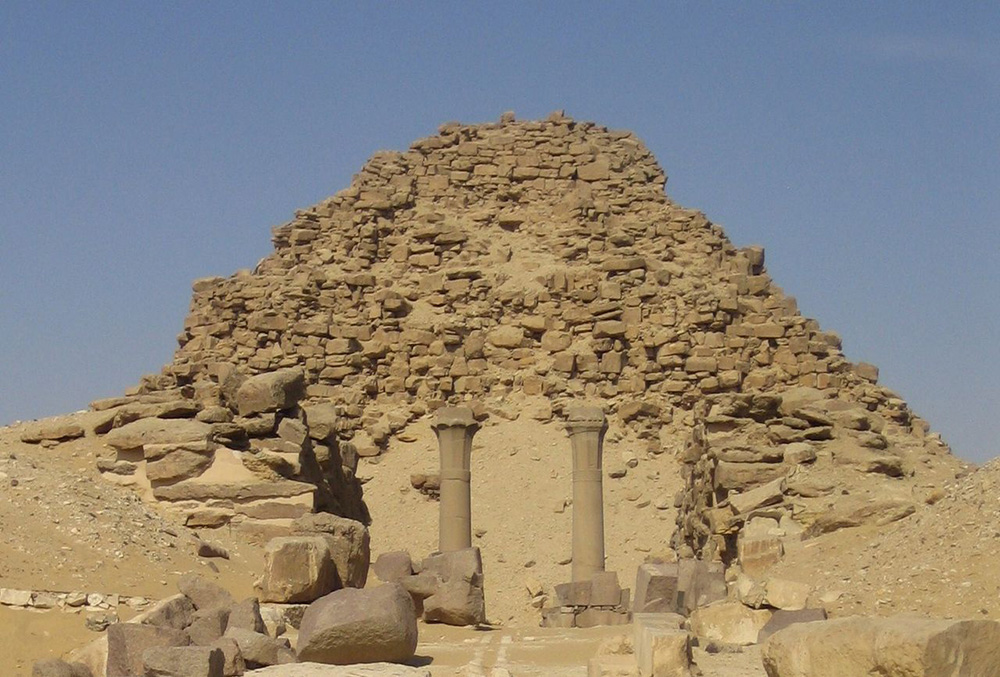
Sahure choose a site near Abusir for his funerary monument, thus constructing the first pyramid in the region. Earlier, the founder of the Fifth Dynasty, Userkaf, had chosen Abusir as the location for his sun temple. It is unclear why Userkaf chose such a remote site. It may have been significant for the nearby cult of Ra, or, in the opinion of the Egyptologist Werner Kaiser, the southernmost point from which the gilded obelisk pyramidion of the temple of Re in Heliopolis could be seen. It is clear, however, that his decision influenced the history of Abusir, including Sahure's decision to build his monument there. Three of the Abusir pyramids, those of Sahure, Neferirkare and Neferefre, are linked at the northwest corners by an imaginary line running to Heliopolis (Iunu). The diagonal was broken by Nyuserre, who positioned his complex between those of Neferirkare and Sahure.
Early excavators neglected to perform thorough investigations of Sahure's monument, perhaps discouraged by its ruined state. In 1838, John Shae Perring, an engineer working under Colonel Howard Vyse, cleared the entrances to the Sahure, Neferirkare and Nyuserre pyramids. Perring was also the first person to enter the substructure of Sahure's pyramid. Five years later, Karl Richard Lepsius, sponsored by King Frederick William IV of Prussia, explored the Abusir necropolis and catalogued Sahure's pyramid as XVIII.The pyramid was re-entered later by Jacques de Morgan, but he too did not explore further. It then remained ignored for fifty years, until the Egyptologist Ludwig Borchardt visited the site.
From 1902-8, Borchardt, working for the Deutsche Orient-Gesellschaft (German Oriental Society), had the Abusir pyramids resurveyed and had their adjoining temples and causeways excavated. From March 1907 to March 1908, Borchardt had Sahure's pyramid thoroughly investigated, and he had trial digs conducted at nearby sites, including Neferefre's unfinished pyramid. He published his discoveries in the two-volume study Das Grabdenkmal des Kšnigs Sahu-re (1910-13), which remains the standard work on the complex.
In 1994, the Egyptian Supreme Council of Antiquities decided to have the Abusir necropolis opened to tourism. In preparation, they had restorative works conducted at Sahure's pyramid. The architect Zahi Hawass had a segment of Sahure's causeway cleaned and reconstructed, during which large relief decorated limestone blocks, that had been buried in the sand, were uncovered. The reliefs found on these blocks were thematically and artistically unique and shed new light on the decorative program of the complex.
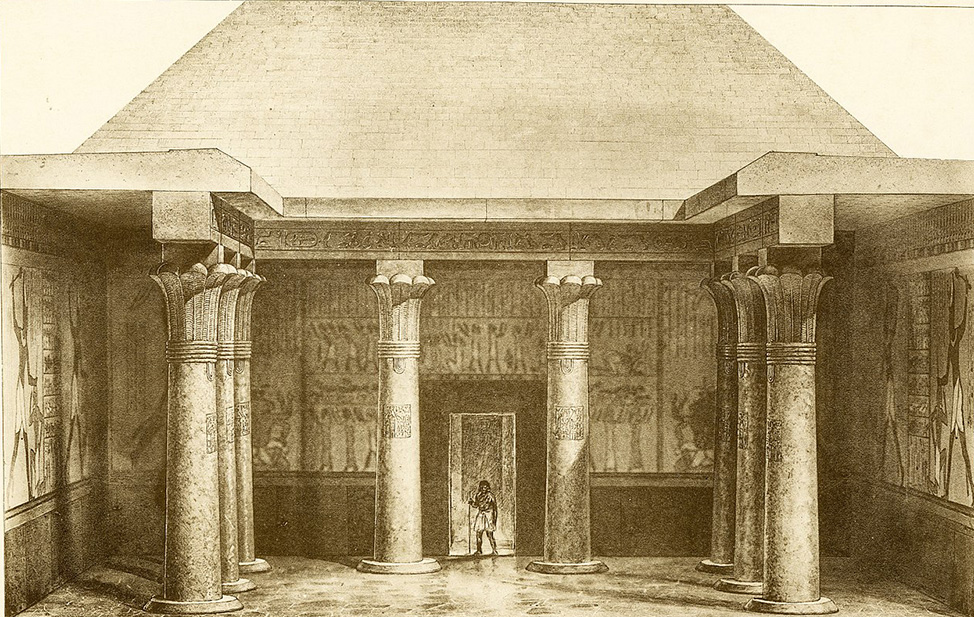
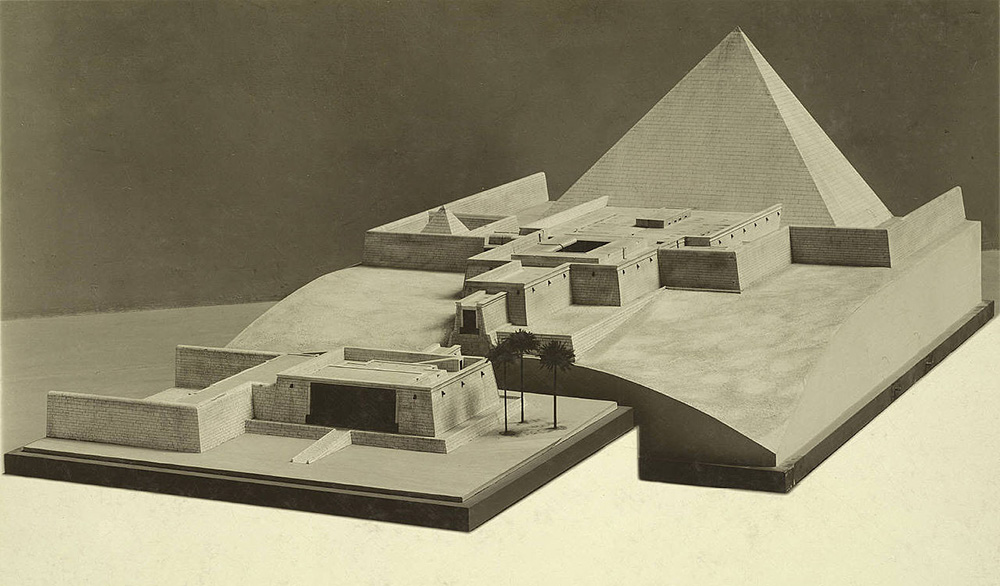
Old Kingdom mortuary complexes typically consist of five main components: (1) a valley temple; (2) a causeway; (3) a mortuary temple; (4) a cult pyramid; and (5) the main pyramid. Sahure's is oriented on the east-west axis, and contains all of these elements. Its 48 m (157 ft; 92 cu) tall main pyramid comprised six ascending steps of stone encased in fine white limestone, with a cult pyramid located at the south-east corner, and a mortuary temple, the standard-bearer for future variants, adjacent its east face. These elements were connected to the valley temple, situated on Abusir lake, by a 235 m (771 ft; 448 cu) long limestone causeway.
Sahure's monument represents a milestone in the development of pyramid construction. Except for minor deviations, the complexes of the Fifth and Sixth Dynasties were modeled after Sahure's. The main pyramids were drastically reduced in size, and adopted simplified construction techniques. The arrangement of the apartments of Sahure's mortuary temple became the model layout for subsequent temples of the type in the Old Kingdom. Relief decoration advanced in wealth of subject matter and quality of workmanship and temples were outfitted with expansive storeroom complexes.
Sahure's temples and causeway are the most expertly decorated containing the most thematically diverse relief-work yet discovered from the Old Kingdom. Across his entire complex, it is estimated that 10,000 m2 (110,000 sq ft) of finely carved relief adorned the walls. His mortuary temple alone contained 370 linear metres (1,214 linear feet) of relief decorations. By contrast, Sneferu's mortuary temple contained 64 linear metres (210 linear feet) of relief decoration, Khufu's contained 100 linear metres (328 linear feet), and, Sahure's direct predecessor, Userkaf's contained 120 linear metres (394 linear feet). The last king of the Old Kingdom, Pepi II's mortuary temple contained 200 linear metres (656 linear feet) of relief decoration, which indicates a decline following Sahure, as well. Unfortunately, no more than 150 m2 (1,600 sq ft) of fragmentary relief has been preserved from Sahure's temple, yet this is considered well-preserved.
The mortuary temple had also been equipped with large storeroom complexes. Of the temple's 4,246 m2 (45,700 sq ft) floorplan, 916 m2 (9,860 sq ft) were reserved for storerooms, accounting for 21.6% of its total area. This was a stark departure from the Fourth Dynasty. The 800 m2 (8,600 sq ft) temple of Sneferu's Red Pyramid at Dahshur, and 2,000 m2 (22,000 sq ft) temple of Khufu's Great Pyramid had no storerooms, while the 1,265 m2 (13,620 sq ft) temple of Khafre's pyramid reserved less than 200 m2 (2,200 sq ft) of space for storerooms, accounting for 15.8% of its total area.
Sahure's pyramid is situated upon a hill elevated 20 metres (66 ft) above the Nile valley. Although the subsoil of the area has never been investigated, evidence from the nearby mastaba of Ptahshepses suggests that the pyramid was not embedded into bedrock, but on a platform constructed from at least two layers of limestone.The pyramid had a, likely horizontally layered, core comprising six ascending steps, five of which remain. The core consisted of low-grade roughly cut limestone, bound with mud mortar, and was encased by fine white limestone acquired from the nearby quarries of Maasara.
Sahure's pyramid was constructed in a drastically different manner to those of the preceding dynasty. Its outer faces were framed using massive - at Neferefre's unfinished pyramid the single step contained blocks up to 5 m (16 ft) by 5.5 m (18 ft) by 1 m (3.3 ft) large - roughly dressed grey limestone blocks well-joined with mortar. The inner chambers were similarly framed, but using significantly smaller blocks. The core of the pyramid, between the two frames, was then packed with a rubble fill of limestone chips, pottery shards, and sand, with clay mortaring. This method, while less time and resource consuming, was careless and unstable, and meant that only the outer casing was constructed using high quality limestone.
Owing to the poor condition of the monument, information regarding its dimensions and appearance contain a degree of imprecision. The pyramid had a base length of 78.5 m (258 ft; 149.8 cu) converging at 5° 30 feet towards the apex 48 m (157 ft; 92 cu) high. The architects made a notable error in demarcating the base, causing the southeast corner of the pyramid to extend 1.58 m (5.2 ft) too far east. Consequently, the base is not square. A ditch was left in the north face of the pyramid during construction which allowed workers to build the inner corridor and chambers while the core was being erected around it, before filling it in with rubble.
The pyramid substructure access is found slightly above ground on the pyramid's north face. A short descending corridor - lined with granite - leads into a vestibule, beyond which the route is guarded by a pink granite portcullis, either side of which the walls are lined with granite. The descending corridor is 4.25 metres (14 ft) long with a slope of 24° 48 feet and has a passage 1.27 m (4.2 ft) wide and 1.87 m (6.1 ft) high. The corridor following - lined with limestone - begins with a slight ascent before becoming horizontal - and lined with granite - just prior to its terminus. The ascending portion is 22.3 m (73 ft) long with a slope of 5ˇ, while the horizontal section is 3.1 m (10 ft) long.
Precise reconstruction of the substructure plan has been rendered impossible as a result of the extensive damage that stone thieves wrought on the chambers. As a result, sources differ as to whether the funerary apartment - estimated to be 12.6 m (41 ft) east-west by 3.15 m (10.3 ft) north-south - consisted of a single chamber, or twin chambers.
In the latter case, the antechamber lies directly on the vertical axis of the pyramid, whilst the burial chamber lies to its west. The chamber(s) had a ceiling constructed from three gabled layers of limestone blocks, which dispersed the weight from the superstructure onto either side of the passageway preventing collapse. The largest blocks were estimated by Perring to be 10.6 m (35 ft; 20.2 cu) long, 3 m (9.8 ft; 5.7 cu) wide and 4 m (13 ft; 7.6 cu) thick. Despite their size and weight, all but two have been broken. Inside the apartment's ruins, Perring found stone fragments - constituting the only discovered remains of the burial - which he believed belonged to the king's basalt sarcophagus.
The pyramid substructure access is found slightly above ground on the pyramid's north face. A short descending corridor - lined with granite - leads into a vestibule, beyond which the route is guarded by a pink granite portcullis, either side of which the walls are lined with granite. The descending corridor is 4.25 metres (14 ft) long with a slope of 24ˇ 48 feet and has a passage 1.27 m (4.2 ft) wide and 1.87 m (6.1 ft) high. The corridor following - lined with limestone - begins with a slight ascent before becoming horizontal - and lined with granite - just prior to its terminus. The ascending portion is 22.3 m (73 ft) long with a slope of 5°, while the horizontal section is 3.1 m (10 ft) long.
Precise reconstruction of the substructure plan has been rendered impossible as a result of the extensive damage that stone thieves wrought on the chambers. As a result, sources differ as to whether the funerary apartment - estimated to be 12.6 m (41 ft) east-west by 3.15 m (10.3 ft) north-south - consisted of a single chamber, or twin chambers.
In the latter case, the antechamber lies directly on the vertical axis of the pyramid, whilst the burial chamber lies to its west. The chamber(s) had a ceiling constructed from three gabled layers of limestone blocks, which dispersed the weight from the superstructure onto either side of the passageway preventing collapse. The largest blocks were estimated by Perring to be 10.6 m (35 ft; 20.2 cu) long, 3 m (9.8 ft; 5.7 cu) wide and 4 m (13 ft; 7.6 cu) thick. Despite their size and weight, all but two have been broken. Inside the apartment's ruins, Perring found stone fragments - constituting the only discovered remains of the burial - which he believed belonged to the king's basalt sarcophagus.
Sahure's, now ruined, valley temple was situated on the shore of Abusir lake, on the edge of the desert. It had a rectangular ground plan 32 m (105 ft; 61 cu) long by 24 metres (79 ft; 46 cu) wide and oriented on the north-south axis. Its base is now around 5 m (16 ft) below ground level, which has risen over the millennia due to the accumulation of silt deposits during the annual Nile flood. The temple's walls slope inwards as they rise, their corners are formed into a convex torus mould up to a cavetto cornice with its own horizontal torus mould.
The temple had two entrances. Its main entrance, in the east, consisted of a landing ramp leading to a column adorned portico. Its floor was paved with polished basalt, its walls had a red granite dado above which was limestone decorated with bas-relief, and it had a limestone ceiling that had been painted blue and decorated with relief-carved golden stars - representing the entrance into the Duat.
The columns were formed into date-palms, with leaves tied vertically to form capitals, and each column bore the king's titulary and name carved into the stone and painted green. An alternate entrance was built on the south side, accessed by a canal leading to a ramp up to another columned portico, this time containing four red granite columns. The columns, in contrast, were cylindrical in form and lacked any crown. This portico was also less deep and was paved with limestone. It remains unclear, why this entrance was built. The wall may belong to Sahure's pyramid town, named "The soul of Sahure comes forth in glory".
The entrances were connected by passages to a T-shaped hall equipped with two columns. Borchardt describes the room as "double staggered" (doppel gestafellt). It has a transverse space with a narrowed recess in its rear wall containing the two columns - the first stagger. Then an even narrower, recess in the first's rear wall - the second stagger. The room was originally adorned with polychromatic relief, and contained a scene depicting the king, as a sphinx or griffin, trampling captive Asiatic and Libyan enemies led to him by the gods. The room connects to two more rooms: a room with a staircase up to the roof terrace at the south end, and causeway at its rearmost recess.
A relief depiction of troops from Sahure's valley temple can be contrasted with similar imagery in Userkaf's complex. In Sahure's scene, the soldiers are carved with near identical postures, a stark contrast to Userkaf's confused arrangement of overlapping figures. The latter has greater dynamism inducing more interest, whilst the former is more readily understood. The monotony of Sahure's scene was balanced by craftsmen introducing detail in the musculature and facial features of the figures
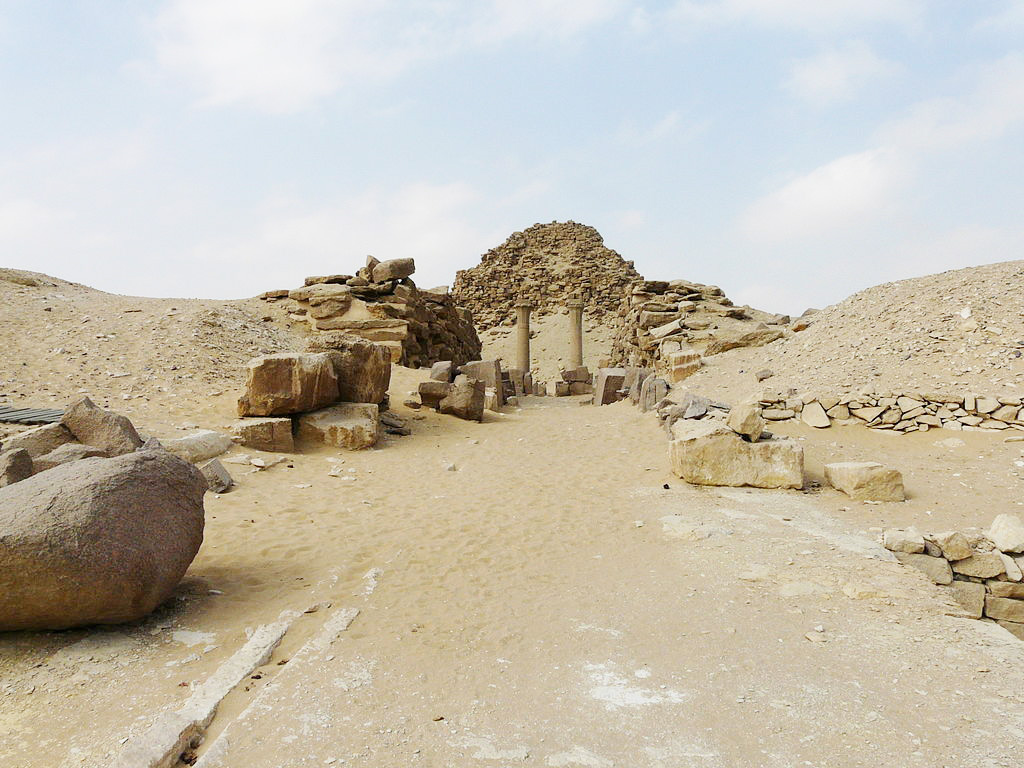
A 235 m (771 ft; 448 cu) long, slightly inclined limestone causeway connected the valley temple to the mortuary temple. The causeway was roofed, with narrow slits left in the ceiling slabs allowing light to enter illuminating its polychromatic bas-relief covered walls.These included scenes with seemingly apotropaic functions, such as a scene of the king represented as a sphinx crushing Egypt's enemies under his paw. Other scenes presented include offering bearers, animal slaughter, and the transport of the gilded pyramidion to the construction site. Only the base of the causeway, made of large limestone blocks, has been preserved.
The scene depicting emaciated Bedouins, who have been reduced, through starvation, to skin and bone had significant historical implications. The scene was thought only to exist in Unas' causeway, and was thus believed to be unique eyewitness testimony to the declining living standards of Saharan Bedouins brought about by the end of the Sahara wet phase in the middle of the 3rd millennium BC. The discovery of an identical scene in Sahure's causeway casts significant doubt onto this hypothesis. Instead, the Egyptologist Miroslav Verner suggests that the Bedouins might have been brought into the pyramid town to demonstrate the hardships faced by pyramid builders bringing in higher quality stone from remote mountain areas.
A second discovered scene has implications for Fifth Dynasty genealogy. In this scene, Sahure is surrounded by his family in the palace garden Wtjs-nfrw-Sahw-ra (Extolled is Sahure's beauty). The image confirms the identity of Sahure's consort, Meretnebty, and his twin sons, Ranefer and Netjerirenre. Ranefer, who is depicted closer to Sahure and bears the titles "king's son" and "chief lector-priest", may have been Sahure's eldest son, ascending to the throne as Neferirkare Kakai. Netjerirenre may instead be the ephemeral ruler Shepseskare, who took the throne after Neferefre's early death.
Another significant relief discovered depicts a procession of ships, led by the king, being moored at an unidentified location. The relief originated on the causeway south wall, and although the location depicted cannot be identified, a corresponding relief on the same wall depicts the king, his mother and wife, awaiting the arrival of ships carrying myriad goods - particular emphasis was placed on the Commiphora myrrha trees from the land of Punt. Sahure's is the earliest recorded voyage taken by the Egyptians to Punt acquiring myrrh, electrum and wood from there.
Sahure is further depicted extracting myrrh with an adze from the tree in one scene, and banqueting with his family, including his sons, and officials near the tree in another. The trees depicted may not be Commiphora myrrha, as the use of an adze to extract resin was typically reserved for the Boswellia tree, and moreover the color of the resin in Sahure's scene was identified by the Egyptologist Tarek El-Awady as yellow-ish brown, like Boswellia frankincense, and not red, like myrrh.
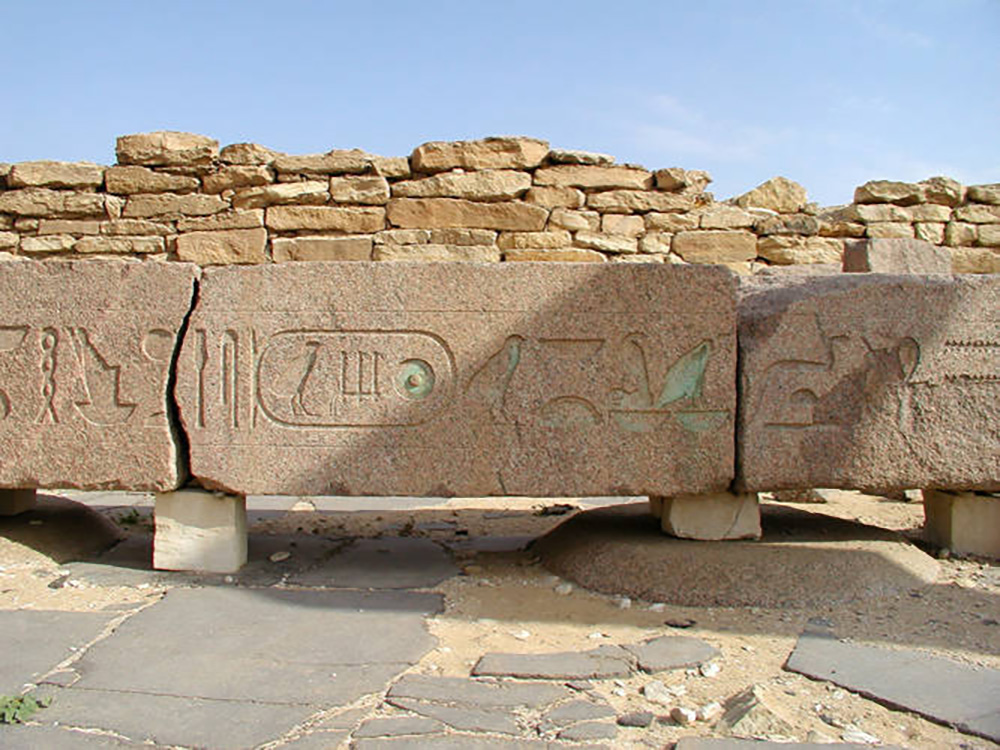
The mortuary temple was a voluminous, rectangular building oriented along the east-west axis,and situated on a level surface built from two layers of limestone blocks in front of the main pyramid's east face. In its layout, Sahure's mortuary temple represented the "conceptual beginning" of all subsequent such temples of the Old Kingdom. It contained five basic elements, exemplified in the temple of Khafre: an entrance hall, an open courtyard, a five niche statue chapel, an offering hall, and storerooms. The dominant building material used in its construction, here as elsewhere, was limestone, but substantial valuable materials such as red and black granite, alabaster and basalt were also incorporated. The temple's outer faŤade was measured to be inclined at 82° up to a cavetto cornice with torus mould.
The transition between causeway and temple was marked by a large granite gate leading into the mortuary temple's entrance hall. In the Fifth Dynasty, it was of the standard size of 21 m (69 ft; 40 cu) long, 5.25 m (17.2 ft; 10.02 cu) wide, and 6.8 m (22 ft; 13.0 cu) tall. The hall has suffered significantly, rendering a precise reconstruction impracticable. It had a limestone floor, its walls had red granite dado above which was, probably, limestone decorated with painted bas-relief scenes, and was covered by a stone barrel vault ceiling which had slits in its tympanum allowing the enclosure to be dimly lit. Contemporary sources identify this room as the pr-wrw meaning "House of the Great Ones", and it may be a replica of the hall of the royal palace, where nobles were received and certain rituals performed. At its end, a granite doorway led to a closed corridor surrounding an open courtyard.
South corridor, which contained the hunting relief,
in relation to the mortuary temple and main pyramid
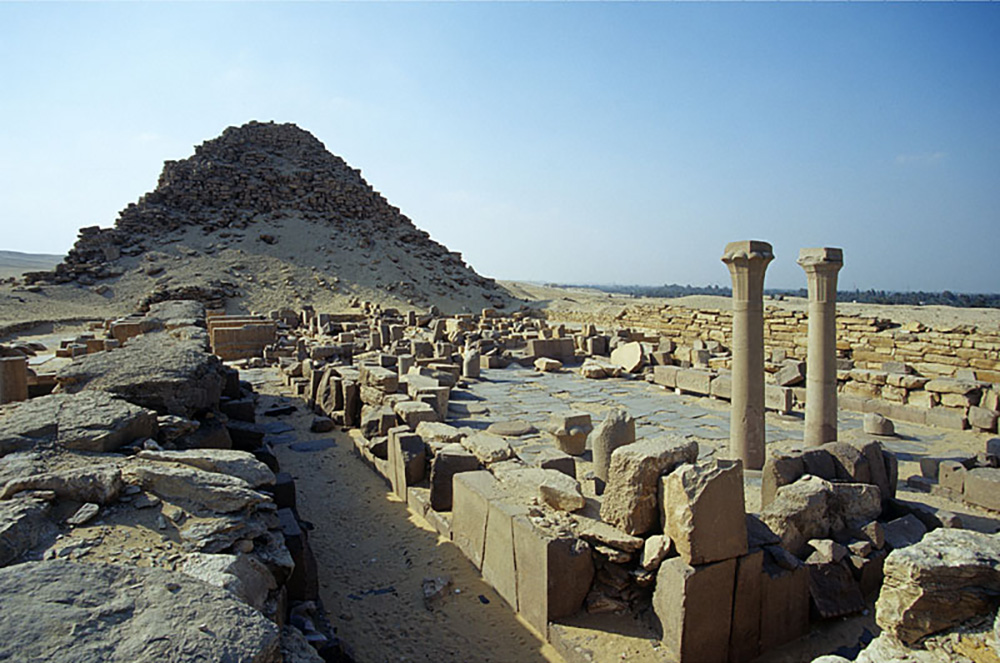
The corridor was paved with basalt, and its walls had a 1.57 m (5.2 ft; 3.00 cu) granite dado, above which they were decorated with colorful relief. On its north wall, scenes depict the king fishing and hunting wildfowl, while on the south wall the king is depicted hunting - antelopes, gazelles, deer and other horned animals are shepherded into an enclosure for the king to shoot with his bow and arrow, after which hound dogs seize and kill the animals, elsewhere hyenas are observed poaching, and hedgehogs and jerboa scatter into their holes - while his courtiers observe.
A masterful depth of detail has been incorporated into the latter scene, which measured 8 m (26 ft) long by 3 m (9.8 ft) high. The sedated posture of the king's courtiers, representing order, is juxtaposed against the mass of wounded and frightened animals depicted in a variety of postures and facing various directions, representing chaos. The imposing figure that is Sahure is unrivaled in any other example, and the gruesome detail of the injured animals is not replicated. The figure of a hyena, pawing at an arrow in its jaw, reappears frequently in the Middle and New Kingdom, an homage to the relief from Sahure's temple. Ptahhotep's tomb in Saqqara contains an abridged, and slightly less skillfully executed, copy of this hunting scene.
The architect Mark Lehner suggests that the corridor represented the untamed wild, surrounding a clearing - the open courtyard - of which the king was guarantor. Referencing reliefs depicting ships on the east-corridor west-wall and west-corridor (transverse corridor) east-wall, the Egyptologist Dorothea Arnold contends that the courtyard and corridor form an architectural unit analogous to the Egyptian benben myth. The other reliefs present symbolize the king's role as guarantor of order and prosperity on the sacred island. Among the reliefs of this room a significant discovery was made.
One of the individuals present has been modified to include a brief inscription identifying them as "Neferirkare King of Upper and Lower Egypt" From this detail, Kurt Sethe, who was responsible for compiling and preparing the scenes for publication, developed the hypothesis that Neferirkare Kakai and Sahure were brothers, and that Neferirkare had had the relief corrected after ascending to the throne..
The open courtyard was paved with polished basalt and lined with sixteen red granite columns, supporting the roof of an ambulatory.Aside from an alabaster altar in the north-west corner decorated with scenes of sacrifice, the open courtyard is bare, though it originally had statues of the pharaoh placed between the columns, and may once also have contained statues of kneeling captives. Eleven of the original sixteen granite columns were found in the temple.
Each was 6.4 m (21 ft) tall, and carved into the form of date palms, symbolising fertility and immortality, upon which the king's name and titulary was inscribed and painted in green. The Two Ladies appear on these columns as well, Nekhbet, the vulture goddess, in the south half representing Upper Egypt, and Wadjet, the cobra goddess, in the north half representing Lower Egypt. Above, a red granite architrave bore the royal titulary, and further supported the limestone ceiling.
The ambulatory's blue painted ceiling was decorated with yellow stars, whilst its limestone walls were decorated with polychrome bas-reliefs, fragments of which have been preserved, depicting the king's victory over his enemies - on the north wall Asiatics, on the south Libyans - and the acquired spoils.
In a particular scene, showing the capture of animals, supplementary inscriptions identify the quantities seized: "123,440 head of cattle, 223,400 asses, 232,413 deer, and 243,688 sheep". In another scene, the family of a Libyan chief beg for his life to be spared whilst the king prepares to execute him. Under the northern ambulatory, a relief of exemplary craftsmanship depicting precious oil vases and Syrian brown bears was found. The figures were given rounded edges so that they simultaneously blend in with the background and stand out clearly. Much of the paint used has been preserved: a dark red-brown color was used for the vase and a yellow-brown for the bear's fur. Up to a further eleven scenes remain too fragmentary to be reconstructed.
By the main pyramid's south-east corner, confined to a separate enclosure, lay a cult pyramid. The enclosure is accessed from either the southern end of the transverse corridor, or through a portico - the side-entrance to Sahure's mortuary temple - flanked by two granite columns bearing Sahure's royal titulary. The portico floor was paved with basalt, as were the dado of its walls, above which the walls were built of limestone and decorated with polychromatic relief. The reliefs portrayed rows of deities, nome and estate personifications, and fertility figures - all clutching was-sceptres and ankh signs - marching into the temple. An accompanying inscription bears their message to the king: "We give you all life, stability, and dominion, all joy, all offerings, all perfect things that are in Upper Egypt, since you have appeared as king of Upper and Lower Egypt alive forever". Behind the portico, a room with two exits allows access to the transverse corridor in the north or to an oblong room preceding the cult pyramid in the south.
The cult pyramid had a core ascending in two or three steps, composed primarily of limestone block debris framed by yellow limestone blocks, and then encased with white limestone blocks - the same method of construction as used in the main pyramid. It had a base length of 15.7 m (52 ft; 30.0 cu) converging at 56ˇ towards the apex 11.6 m (38 ft; 22.1 cu) high. From the north face, a bent corridor - initially descending, then switching to an ascent - leads into the miniature pyramid's sole chamber: an east-west oriented burial room found slightly below ground level. The chamber was found void of any content, and its walls had been severely damaged by stone thieves.
The purpose of the cult pyramid remains unclear. Its burial chamber was not used for burials, but instead appears to have been a purely symbolic structure. It may have hosted the pharaoh's ka (spirit), or a miniature statue of the king. It may have been used for ritual performances centering around the burial and resurrection of the ka spirit during the Sed festival.
During the Eighteenth Dynasty, the south corridor of Sahure's mortuary temple became home to a cult of Sekhmet. Its early history is unknown, and though Borchardt suggested that the cult had its origins in the Middle Kingdom, there is no evidence to support this conjecture. The earliest attested royal connection to cult is Thutmose IV, of the Eighteenth Dynasty, followed later by Ay and Horemheb.Amenhotep III, of the Eighteenth Dynasty,has been connected to the temple through a faience object bearing his name, as have Seti I and Ramesses II, of the Nineteenth Dynasty of Egypt, through restoration inscriptions bearing their names.
The renewed attention had a negative consequence as the first wave of dismantlement of the Abusir monuments, particularly for the acquisition of valuable Tura limestone, arrived with it. Sahure's mortuary temple may have been spared at this time due to the presence of the cult. The cult's influence likely waned after the end of Ramesses II's reign, becoming a site of local worship only.
The Abusir necropolis and Sahure's cult garnered attention once again in the Twenty-Fifth and/or Twenty-Sixth Dynasties, as evidenced by the copying of relief art from the monuments. Taharqa, of the Twenty-Fifth Dynasty, had various reliefs replicated - such as images of the king crushing his enemies as a sphinx - from the mortuary temple's of Sahure, Nyuserre, and Pepi II for the restoration of the temple of Kawa in Nubia.
In the late Twenty-Sixth to the early Twenty-Seventh Dynasty, a new period of dismantlement appears to have been visited on the monuments. Sahure's was once again spared, protected by the cult into the Ptolemaic Kingdom, though it had very reduced influence at this time. A third wave of dismantlement of the Abusir monuments is clearly attested in the Roman period by the abundant remains of mill-stones, lime production facilities, and worker shelters. At the beginning of the Christian era, Copts founded a shrine in the temple,= as shown by pottery and Coptic graffiti dating to between the fourth and seventh centuries AD.= Periodic farming of the monuments for limestone continued at least until the end of the 19th century AD.
-
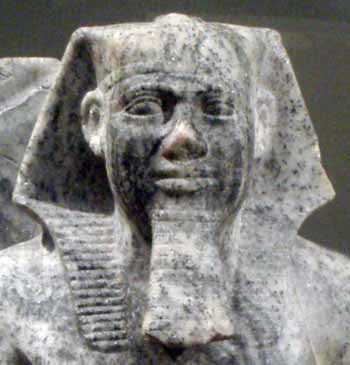
Sahure